Viewfinders
Discussion of the viewfinders used on
the Eclair NPR must first start with a description of the camera's viewing
system. The NPR is equipped with reflex viewing. That is, the operator is
looking through the actual taking lens and sees the exact same image that
is being sent to the film aperture. This is very different from a camera
like the B&H Filmo where the operator peers into a finder running parallel
to the actual lens. With a camera like this you would see an image approximately
similar in size and position to what the film aperture would see but it is
not the actual
image.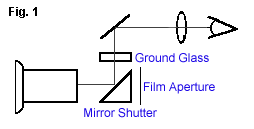 As you
got closer to the subject the image seen by the lens and the one seen by
the finder would move further away from each other due to the element of
parallax error. Reflex viewing is obviously preferable because it provides
for parallax-free viewing since the operator and the camera see the same
thing. It also helps to insure the image being presented to the film is properly
focused and framed. Depending on the particular camera, the image from the
lens can be split between the film aperture and the viewfinder using a prism
or beam splitter or it can be alternated between the two using a mirror type
shutter. Using a system that splits or divides the light from the lens is
less desirable than one that alternates because of the potential for tremendous
light loss to the film aperture.
As you
got closer to the subject the image seen by the lens and the one seen by
the finder would move further away from each other due to the element of
parallax error. Reflex viewing is obviously preferable because it provides
for parallax-free viewing since the operator and the camera see the same
thing. It also helps to insure the image being presented to the film is properly
focused and framed. Depending on the particular camera, the image from the
lens can be split between the film aperture and the viewfinder using a prism
or beam splitter or it can be alternated between the two using a mirror type
shutter. Using a system that splits or divides the light from the lens is
less desirable than one that alternates because of the potential for tremendous
light loss to the film aperture.
With the NPR, the shutter is fitted with
a high-gain mirror that rotates at a 45 degree angle to the lens (Fig. 1).
During the time the shutter is closed and is blocking all light from reaching
the film aperture, almost 100% of that light is being reflected by this mirror
surface up to the ground glass focusing screen. From here the light is again
bent 90 degrees by another mirror and sent across to the port opening for
the viewfinder. Because the ground glass is precisely fixed within the camera,
itself, it cannot shift in position.
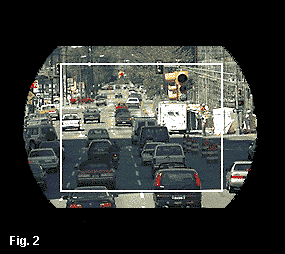 Once calibrated
by the camera technician in terms of lens flange distance and
reticule-to-aperture alignment, it will remain permanent. Removal and
reinstallation of the viewfinder will not affect the ground glass in any
way. All framing and focusing is now done against this constant. The viewfinder's
objective is first focused by the operator so that the grain of the ground
glass is clearly defined. The taking lens is then focused to produce a sharp
image on the same ground glass. Another feature of the NPR's viewing system
is the lack of an aperture mask. Without the introduction of this mask to
block off that part of the lens that does not reach the film aperture, the
operator is given access to much more of what the lens actually sees. This
can be explained in Fig. 2. The lens, being round in nature, actually produces
an image that is round. The film aperture, however, is a rectangle that must
sit well within this round world. The end result is a certain percentage
of image the lens sees that will never reach the film. The operator, being
the inquisitive type, will gladly make use of this extra image. For him/her
this extra visual information outside the film frame will help in determining
where and when to move the camera to get the next best shot.
Once calibrated
by the camera technician in terms of lens flange distance and
reticule-to-aperture alignment, it will remain permanent. Removal and
reinstallation of the viewfinder will not affect the ground glass in any
way. All framing and focusing is now done against this constant. The viewfinder's
objective is first focused by the operator so that the grain of the ground
glass is clearly defined. The taking lens is then focused to produce a sharp
image on the same ground glass. Another feature of the NPR's viewing system
is the lack of an aperture mask. Without the introduction of this mask to
block off that part of the lens that does not reach the film aperture, the
operator is given access to much more of what the lens actually sees. This
can be explained in Fig. 2. The lens, being round in nature, actually produces
an image that is round. The film aperture, however, is a rectangle that must
sit well within this round world. The end result is a certain percentage
of image the lens sees that will never reach the film. The operator, being
the inquisitive type, will gladly make use of this extra image. For him/her
this extra visual information outside the film frame will help in determining
where and when to move the camera to get the next best shot.
 There were only two viewfinders offered
by Eclair for the NPR. The first, which came installed on Eclairs released
in 1963, was a viewfinder made by the French optics and lens manufacturer,
Kinoptic. The Kinoptic magnified the image by twelve times and was designed
to enable either left or right eye viewing by simply swinging the objective
arm away from or towards the camera.
There were only two viewfinders offered
by Eclair for the NPR. The first, which came installed on Eclairs released
in 1963, was a viewfinder made by the French optics and lens manufacturer,
Kinoptic. The Kinoptic magnified the image by twelve times and was designed
to enable either left or right eye viewing by simply swinging the objective
arm away from or towards the camera.
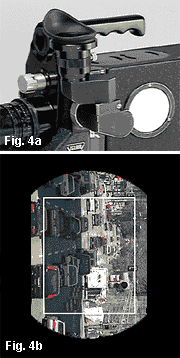 The objective
could be adjusted to the operators eye strength by plus or minus six diopters.
A rather large, relatively bright eyepiece was provided. A built-in light
trap to close off the eyepiece was included to keep light from travelling
back down the viewfinder and fogging the film. Normally in the closed position,
it was activated by pressure from the operator's eye against the rubber eyecup.
Although this early model was known as a rotating viewfinder, this
terminology can be very misleading and needs some explaining. By releasing
the locking screw at the front of the optics tube, the finder could,
in fact, be rotated 360 degrees around. However, it would only show an image
that was erect and level with the taking lens when the eyepiece was parallel
to the camera, as is shown in Fig. 3. In fact, there is a detent that snaps
the finder into place when you reach this position so there is no mistaking
it! In any other position other than this, the image would exhibit some
degree of tilt. For example, if the eyepiece was straight up and down, exactly
perpendicular to the camera, as in Fig. 4a, the image would be rotated at
a 90 degree angle clockwise as in Fig 4b. Pushing the finder more forward
would continue the tilt on around until the image was completely upside down.
All cameras of this early vintage had similar style finders that did not
allow off-axis viewing. Few, if any, even allowed the finder to rotate. They
were usually fixed against the side of the camera. This was a condition that
early documentary filmmakers simply had to live with...and they did just
fine.
The objective
could be adjusted to the operators eye strength by plus or minus six diopters.
A rather large, relatively bright eyepiece was provided. A built-in light
trap to close off the eyepiece was included to keep light from travelling
back down the viewfinder and fogging the film. Normally in the closed position,
it was activated by pressure from the operator's eye against the rubber eyecup.
Although this early model was known as a rotating viewfinder, this
terminology can be very misleading and needs some explaining. By releasing
the locking screw at the front of the optics tube, the finder could,
in fact, be rotated 360 degrees around. However, it would only show an image
that was erect and level with the taking lens when the eyepiece was parallel
to the camera, as is shown in Fig. 3. In fact, there is a detent that snaps
the finder into place when you reach this position so there is no mistaking
it! In any other position other than this, the image would exhibit some
degree of tilt. For example, if the eyepiece was straight up and down, exactly
perpendicular to the camera, as in Fig. 4a, the image would be rotated at
a 90 degree angle clockwise as in Fig 4b. Pushing the finder more forward
would continue the tilt on around until the image was completely upside down.
All cameras of this early vintage had similar style finders that did not
allow off-axis viewing. Few, if any, even allowed the finder to rotate. They
were usually fixed against the side of the camera. This was a condition that
early documentary filmmakers simply had to live with...and they did just
fine.
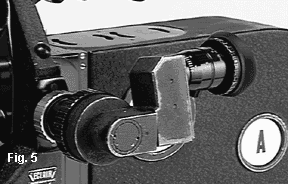 It was not until sometime around early 1969 that the French lens
manufacturer, Angenieux, introduced a new viewfinder for 16mm cameras like
the Eclair, Photosonics and Frezzolini that was truly orientable as
well as rotatable (see Fig. 5). Through the use of a porro abbe prism within
the design, the Angenieux viewfinder now made it possible for the operator
to shoot comfortably at any angle and camera height.
It was not until sometime around early 1969 that the French lens
manufacturer, Angenieux, introduced a new viewfinder for 16mm cameras like
the Eclair, Photosonics and Frezzolini that was truly orientable as
well as rotatable (see Fig. 5). Through the use of a porro abbe prism within
the design, the Angenieux viewfinder now made it possible for the operator
to shoot comfortably at any angle and camera height.
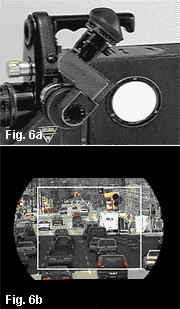 With this new
finder, the eyepiece could be rotated to any position around a 360 degree
axis (see Fig. 6a) and still maintain an image that was erect and level at
all points within the arc (see Fig 6b). Unlike the Kinoptic, there were no
detents in the rotation at 45 degree intervals. Rather, there was a friction
drag adjustment collar which also served to lock off the finder at any position.
Like the Kinoptic that proceeded it, there was complete adjustment for left
and right eye viewing and a diopter adjustment of plus or minus five diopters.
An addition, if the objective was disassembled, a technician could further
tune the strength another few diopters either way. The Angenieux used a manually
activated light trap consisting of a rotating ring located just
behind the back of the eyepiece to close off the optics from extraneous light.
It is also important to note the Angenieux viewfinder was also at least 100%
brighter than the Kinoptic. That means a gain of at least one full stop in
viewing brightness which was a great help to the operator shooting wide open
in available light!
With this new
finder, the eyepiece could be rotated to any position around a 360 degree
axis (see Fig. 6a) and still maintain an image that was erect and level at
all points within the arc (see Fig 6b). Unlike the Kinoptic, there were no
detents in the rotation at 45 degree intervals. Rather, there was a friction
drag adjustment collar which also served to lock off the finder at any position.
Like the Kinoptic that proceeded it, there was complete adjustment for left
and right eye viewing and a diopter adjustment of plus or minus five diopters.
An addition, if the objective was disassembled, a technician could further
tune the strength another few diopters either way. The Angenieux used a manually
activated light trap consisting of a rotating ring located just
behind the back of the eyepiece to close off the optics from extraneous light.
It is also important to note the Angenieux viewfinder was also at least 100%
brighter than the Kinoptic. That means a gain of at least one full stop in
viewing brightness which was a great help to the operator shooting wide open
in available light!
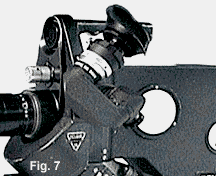 While there are claims that other finders
can be used on the NPR, the operator should be careful. The orientable viewfinder
made by Cinema Products for the CP-16R (see Fig. 7) is optically and mechanically
compatible with the NPR however the prism arm is mounted on the front of
the optics tube (similar to the finder on the Eclair ACL), rather than on
the rear like the Angenieux. This means the distance between the eyecup and
the operators eye is increased dramatically from where it should be. The
result is the need to hyper-extend ones neck forward at least an inch or
more to reach the eyepiece. While this finder should work just fine in situations
where the camera is on a tripod, using it when shooting off the shoulder
may be painful, to say the least.
While there are claims that other finders
can be used on the NPR, the operator should be careful. The orientable viewfinder
made by Cinema Products for the CP-16R (see Fig. 7) is optically and mechanically
compatible with the NPR however the prism arm is mounted on the front of
the optics tube (similar to the finder on the Eclair ACL), rather than on
the rear like the Angenieux. This means the distance between the eyecup and
the operators eye is increased dramatically from where it should be. The
result is the need to hyper-extend ones neck forward at least an inch or
more to reach the eyepiece. While this finder should work just fine in situations
where the camera is on a tripod, using it when shooting off the shoulder
may be painful, to say the least.
On a personal level, when I purchased
my NPR I was simply not aware there were two different types of viewfinders
so I ended up with the Kinoptic. I have since purchased the Angenieux and
I'm glad I did. While the Kinoptic was more than satisfactory for off the
shoulder shooting, it was very cumbersome to use when shooting an interview.
I found I had to get down on my knees to look into the viewfinder. With the
Angenieux I can now make just the slightest tweak to the viewfinder to get
the perfect position for every shooting situation I find myself in. It has
certainly been a very freeing experience for me and it can only help to improve
my camera technique. Perhaps I've been spoiled from shooting video for so
long although one of my first film cameras was a Bolex DS-8 and I shot interviews
on my knees with that, as well.

